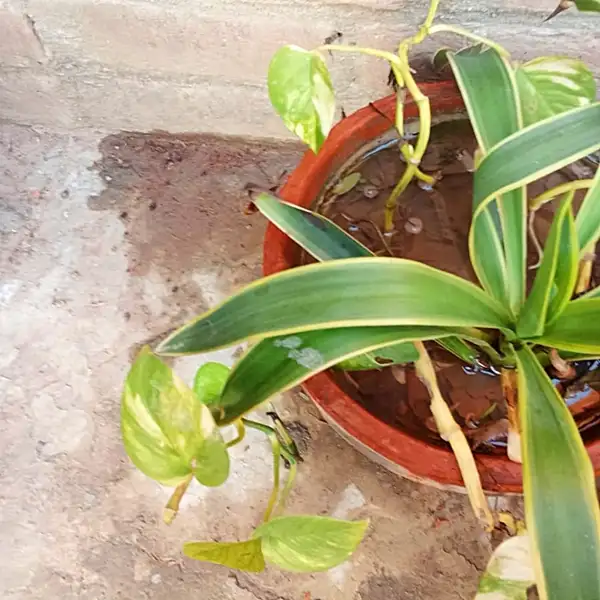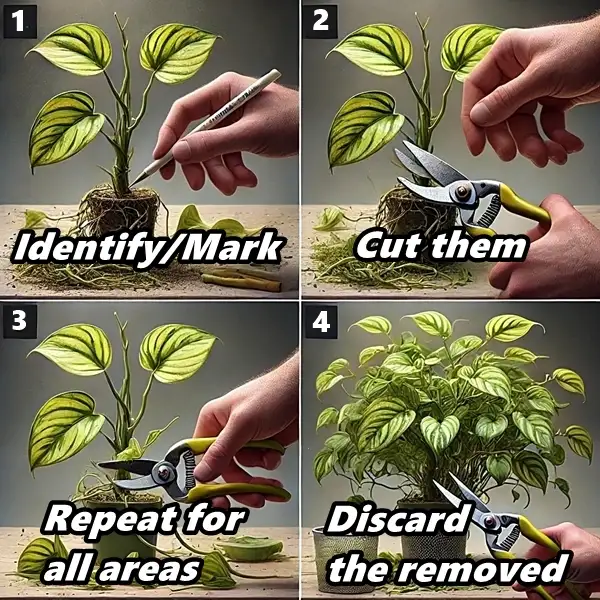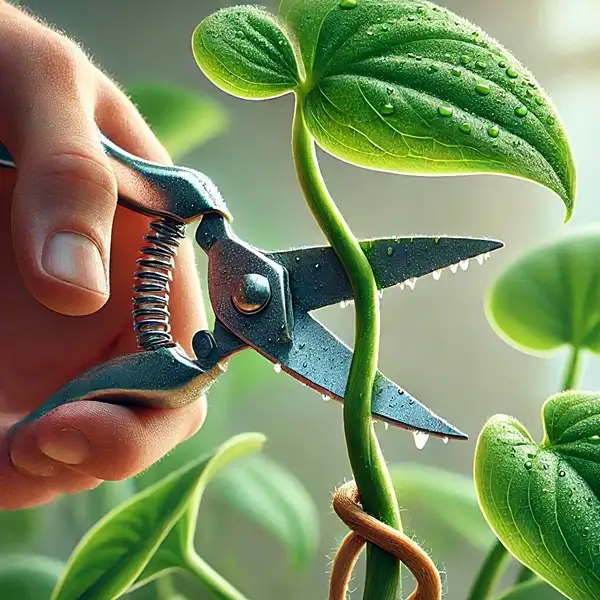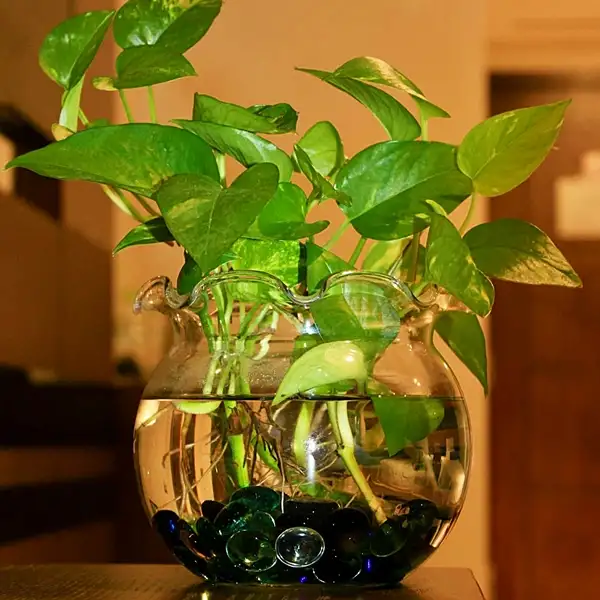Key Takeaways
| Key Takeaways | Why It Matters |
|---|---|
| The Secret to a Fuller Pothos | Discover how a simple technique can make your plant thrive. |
| Timing is Everything | Learn when to prune for maximum growth and health. |
| Tools You Didn’t Know You Needed | How to prune Pothos? Ensure every cut leads to a healthier, stronger pothos. |
| Avoiding Costly Mistakes | Find out the biggest pruning errors and how to prevent them. |
| Helping Your Pothos Bounce Back | Master the post-pruning steps that guarantee success. |
Importance of Pruning Pothos
Pothos, scientifically known as Epipremnum aureum, is a popular & hardy houseplant. It is enjoyed by many for its versatility in terms of growth habit & care requirements. However, with these benefits comes need for regular maintenance to ensure a healthy plant. One such routine task is pruning.
Pruning not only helps keep your Pothos from becoming excessively long or leggy but also encourages bushier growth & stimulates healthier foliage. This process removes dead leaves or stems that could potentially cause drains on plant’s resources; thus leading to poor health, slow growth rate or susceptibility to pests & diseases.

It is easy to overlook pruning as unnecessary plant torture due to misconceptions about hurting our green companion. In actuality though, when done correctly at appropriate intervals (as determined by observing your plant), it becomes an important stimulating factor in regeneration of pothos plants thereby creating fuller leaf development.
Larry Hodgson from the Laidback Gardener Blog says.
“When you prune your plants carefully, you stimulate growth in spots that would otherwise remain dormant.”
That’s why nurturing this regenerative cycle preserves their attractiveness while improving overall health – remember nature isn’t always neat!
When Is The Right Time To Prune Your Pothos?
Pruning Timing Based on Growth & Space
The best time for pruning largely depends on individual preference based on how much one expects their pothos vine to grow versus how much space one has allotted for the same.
Color Changes as Pruning Indicators
Despite stating this subjective judgment on ‘when’ another definitive factor involves identifying color changes signifying distress – yellowing leaves indicating over watering or browning tips indicating low humidity.
Seasonal Growth & Trimming Adjustments
Depending upon factors like how fast it grows each season (typically faster during spring/summer compared slower rate during fall/winter), periodic examinations every couple weeks will help determine if it needs adjustment through light trimming.
Aesthetic Preferences Influence Pruning Frequency
Aesthetic preferences can drastically change timing considerations for pruning.
For example: If you like bushier plants with more leaves, pruning might be done more frequently. Conversely, if the long vine look is what you’re going for in your home or office environment, then less frequent pruning may be ideal.
4 Necessary Tools & Preparations for Pothos Pruning
Before getting started on actual act of pruning, gather all necessary tools to ensure a streamlined process.
| Tool/Preparation | Description |
|---|---|
| Pruning Shears, Scissors |
|
| Cleaning Solution |
|
| Protective Gloves (ideally rubber) |
|
| Waste Disposal |
|

Step-by-Step Guide to Properly Prune Pothos
Pruning Pothos can seem overwhelming initially, however, following basic steps ensures an effective procedure causing the least damage during process:
| Step | Action | Purpose |
|---|---|---|
| 1 | Identify & mark leggy or unhealthy stems | Targets areas/sections needing removal to promote healthier growth |
| 2 | Make a cut using sanitized cutting instrument (e.g., shear/scissor/knife) just above a leaf node, about ½-inch away – since new growth occurs from here | Encourages new growth from the node |
| 3 | Repeat for all areas needing trimming | Ensures even and controlled pruning |
| 4 | Discard removed foliage appropriately | Keeps the area tidy & prevents disease spread |
Not only does this facilitate healthy growth, but it also enables propagation through rooting cut pieces if placed correctly inside a potting soil-enriched compost mixture providing ample moisture & light sources respectively.

4 Common Challenges in Pruning Pothos (+Fixes)
Pothos pruning is generally a straightforward process, however it is not uncommon to encounter occasional challenges.
| Challenge | Solution |
|---|---|
| Over-pruning |
|
| Plant not growing after pruning |
|
| Yellowing leaves after pruning |
|
| Slow recovery |
|
‘The key is patience, So, Don’t rush things!’ says Toby Bost, author of Carolina Gardener’s Handbook.
1 Serious Mistake to Avoid
- To avoid most of the adversities remember to always sterilize equipment first before cutting away.

4 Essential Care Tips for Pothos After Pruning
Finally, post-pruning care provides necessary stimuli for strong regrowth & keeps plants healthy & resilient in long run.
| Care Step | Action |
|---|---|
| Watering |
|
| Light |
|
| Humidity |
|
| Fertilization |
‘Use a slow-release fertilizer once a year post-pruning.’
|
Frequently Asked Questions
How do I cut my pothos to grow more?
Cut just above a leaf node using sterilized scissors. This encourages new shoots & bushier growth. Avoid removing more than one-third at a time to prevent stress.
How do you prune dead pothos?
Trim dead or yellowing leaves at base. Use disinfected shears to prevent disease. Gradual pruning helps plant recover efficiently.
Does pruning pothos promote growth?
Yes! Pruning redirects energy to healthier sections & stimulates new shoots & fuller foliage.
How to keep pothos bushy?
Prune regularly above leaf nodes. Provide bright, indirect light & rotate plant for even growth.
How do you save a dead pothos?
Check roots & trim any mushy, black ones. Repot in fresh soil, water moderately & provide indirect light. Propagate healthy cuttings if needed.
Should I cut off the dead parts of my plant?
Yes! Removing dead leaves & stems prevents energy waste & reduces disease risk.
Should I cut off pothos leaves with brown spots?
Trim severely damaged leaves. If spots are minor, adjust care routines instead.
What do dead pothos roots look like?
They appear mushy, dark brown or black & may smell bad. Trim affected roots & improve drainage.








